#brown v. board of education
Explore tagged Tumblr posts
Photo


On this day in 1908: Thurgood Marshall, the first Black Supreme Court Justice of the United States, was born in Baltimore, Maryland.
As the NAACP’s chief counsel from 1938 to 1961, Marshall challenged racial segregation in more than a dozen cases before the Court. He won nearly all of these cases, including a critical victory in Brown v. Board of Education.
Celebrating Justice Marshall’s life and legacy today!
#on this day#Thurgood Marshall#scotus#supreme court#history#brown v. board of education#naacp#birthday
105 notes
·
View notes
Text
Dean Obeidallah at The Dean's Report:
The push and pull between white supremacist rule and a multi-cultural United States is nothing new. But on Friday we saw a first in our nation’s history: A school board voted to restore the name of three Confederate generals to their public schools. That’s right, in 2024, the right is naming schools after people who fought and killed to preserve both chattel slavery and white supremacy. This is just the latest salvo in the GOP’s campaign to move America backwards to before the Civil Rights movement.
This jaw-dropping event happened on Friday, when the Shenandoah County School Board in Virginia voted 5-1 to reinstate the names Stonewall Jackson High School and Ashby Lee Elementary School to honor Confederate Generals Thomas “Stonewall” Jackson, Robert E. Lee and Turner Ashby. This vote to celebrate the traitors who killed US soldiers in the hope of maintaining the barbarism known as chattel slavery was led by the conservative group Coalition for Better Schools. Now the school board will spend an estimated six figures in tax dollars to send a message that this area of Virginia is a place where white supremacy rules. This action is all part of the right’s response to the racial reckoning that was kicked off in the United States after the brutal murder of George Floyd in 2020 and the Black Lives Matter protests that followed. In fact, the names of these Virginia schools were changed in that very period. But this is not simply a “reinstatement” of Confederate names. Rather this is a manifestation of the white right’s desperate efforts to maintain control in the face of changing America. After all, this is exactly what white supremacists did in the past when they felt challenged.
As a reminder, the greatest number of Confederate statutes were erected in the early 1900’s spearheaded by United Daughters of the Confederacy as Jim Crow laws were being enacted across the South. These racist laws and the Confederate memorials were part of a scheme to both celebrate and preserve white supremacy. The next spike in Confederate monuments came from 1940’s to 1960’s. Why then nearly 100 years after the Civil War? Simple, these statutes were built in reaction to the Civil Rights movement to send a message that white power still ruled that area. It’s no coincidence that in 1956, Georgia redesigned its state flag to include the Confederate battle flag and in 1962, South Carolina placed the Confederate battle flag atop its capitol building.
When it comes to schools being named after traitors who took up arms against the United States of America to fight for the Confederacy, want to guess when the biggest wave of that occurred? Was it shortly after The Civil War? Nope, it was following the landmark US Supreme Court decision Brown v. Board of Education in 1954 which ruled that segregated public schools were unconstitutional. Between that 1954 court decision and 1970, our nation saw the largest spike in schools being after those who fought to defend slavery. In fact, the schools at issue in Virginia were opened in that time frame, with Stonewall Jackson high school opening in 1960. That’s right. The naming of these Virginia schools was part of the backlash to the Civil Rights movement and Brown v. Board of Education. The white officials in that area of Virginia at the time wanted to ensure that people knew white power still reigned supreme.
Dean Obeidallah gets to the point as usual. The renaming of a pair of schools in Shenandoah County, Virginia by reinstating the name of the pre-2020 names of the schools named after three treasonous Confederates (Thomas “Stonewall” Jackson, Robert E. Lee, and Turner Ashby) is a middle finger to common sense and a win for white supremacist values.
#Dean Obeidallah#Schools#Confederacy#Shenandoah County School Board#School Boards#Virginia#White Supremacy#Coalition for Better Schools#Slavery#Brown v. Board of Education#Civil Rights Movement
43 notes
·
View notes
Text
On July 31, 1963, almost a decade after Brown v. Board of Education prohibited racial segregation in public schools, the University of North Alabama, known at the time as Florence State College, denied admission to Wendell Gunn, a Black applicant, based solely on his race. The school’s rejection letter stated explicitly, “Neither the Alabama Legislature nor the State Board of Education ha[s] authorized the college to accept Negroes.”
UNA officials later admitted that it was evident from Mr. Gunn’s application that he had a “very good academic record.” At the time, Mr. Gunn was a chemistry major at Tennessee Agricultural & State Normal School, a historically Black college that later became Tennessee State University. Despite the fact that Mr. Gunn lived just 10 miles from UNA, he had been forced to attend college out-of-state because Alabama insisted on keeping its schools all-white.
Three weeks after being denied admission, Mr. Gunn filed suit in federal court. A U.S. District Judge ordered UNA to admit Mr. Gunn for the fall term, which began in September.
In response to the court order, white citizens in Alabama criticized UNA for discriminating in such a blatant, written form, rather than discriminating in the covert methods typically used. White citizens complained that the school’s actions “eliminated any chance of stalling tactics by school officials” and undermined “pieces of legislation carefully written to slow school integration.” Others predicted that Governor George Wallace would block Mr. Gunn’s admission by physical force, in defiance of the court order, as he attempted to do in June, when Black students Vivian Malone and James Hood integrated the University of Alabama. Due to the level of hostility in the white community and the potential for violence, UNA held a separate, after-hours enrollment session for Mr. Gunn, after white students left campus for the day on September 11.
Historically segregated public colleges in Alabama, like the University of North Alabama, which had been an all-white state-funded institution since 1830, declined to admit a single Black student in the nine years following Brown. Violent white resistance to integration necessitated federal intervention to protect Black students on multiple occasions in Alabama, but Alabama continued to defy federal integration orders, to deny admission to Black applicants, and to enforce discriminatory state laws that conflicted with the U.S. Constitution. To learn more about white resistance to integration in Alabama and across the country, read EJI’s report, Segregation in America.
#history#white history#us history#am yisrael chai#jumblr#republicans#black history#democrats#Brown v. Board of Education#University of North Alabama#Alabama#Segregation in America#end the apartheid#apartheid#israel#palestine#israeli apartheid#American apartheid
6 notes
·
View notes
Text
Supreme Court Bracket
Remember that this is a silly Tumblr poll, and these two things are not actually in conflict. So don't get too heated in the notes.


The New Deal. National Labor Relations Board v Jones & Laughlin Steel Corporation was a US labor law case. It declared that the National Labor Relations Act of 1935 was constitutional. It effectively preserved the New Deal, which was being pursued by US President Roosevelt in reaction to the Great Depression. Previous Supreme Court cases, unlike NLRB v. Jones & Laughlin, had invalidated New Deal statutes.
School Desegregation. The case Brown v. Board of Education the Court declared state laws establishing separate public schools for black and white students to be unconstitutional. It stated that ''separate educational facilities are inherently unequal.''
#xkcd#polls#tumblr polls#polls on tumblr#poll tournament#supreme court#law#us law#us politics#american politics#NLRB v. Jones & Laughlin#Brown v. Board of Education#The New Deal#School Desegregation#0x3v0xc#Supreme Court Round 2
6 notes
·
View notes
Text
A Pragmatic and surprisingly comforting perspective about the Trump 2nd Presidency from the ACLU
***Apologies if this is how you found out the 2024 election results***
Blacked out part is my name.

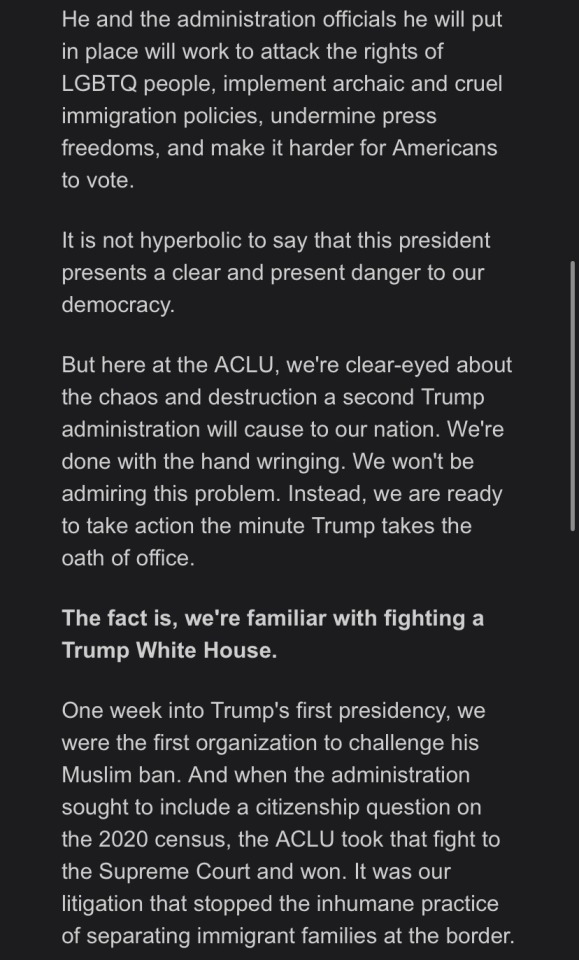
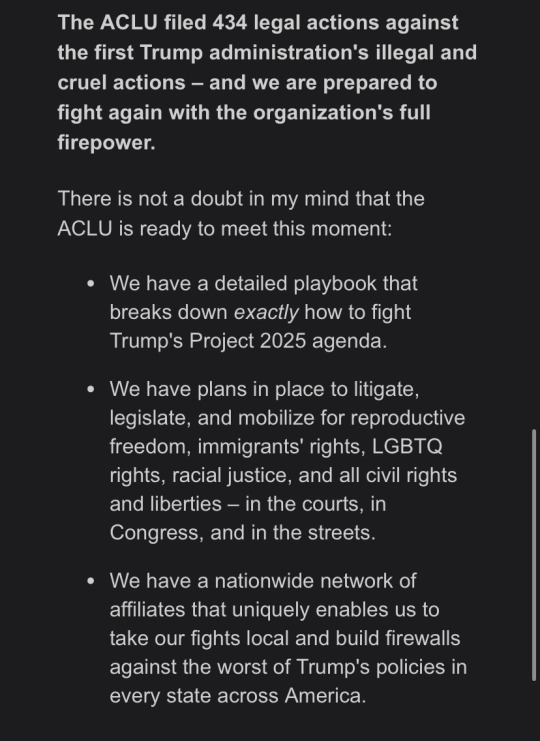
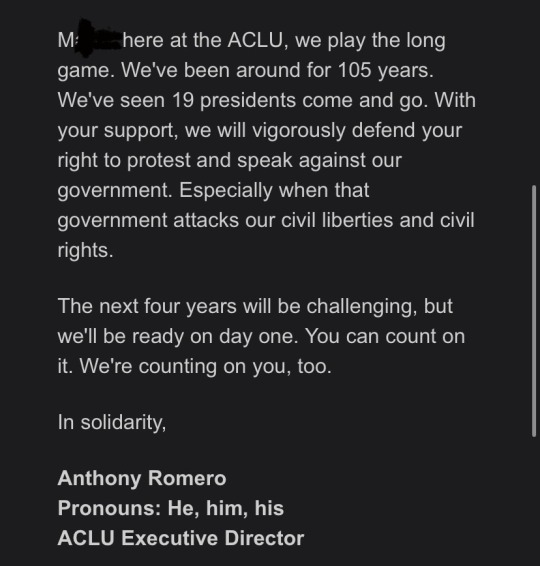
I’m not going to let this make me give up. It’s disheartening, and today I will wallow, probably tomorrow too
AND
I will continue to do my part in my community to spread the activism and promote change for the world I want to live in. I want to change the world AND help with the dishes.
And I won’t let an orange pit stain be what stops me from trying to be better.
A link to donate to the ACLU if able and inclined. I know I am
#us politics#donald trump#election 2024#aclu#a promise to myself#how is this comforting you May ask#bc we are not fighting alone or uninformed#we have good and strong groups in our corners defending what we believe in#it’s not over yet#we have to try and pushback#added Alt image descriptions since this is leaving containment#happy to see many engaging with this to either donate time or money or both#really warms the cold heart of mine#wow this broke containment#overall it’s been pretty nice seeing people engaging with it ready to roll up their sleeves and get to work#they did the travel ban right at the beginning of the previous presidency too#also every major civil battle in the last century#brown V board of education- the one that desegregated schools#loving V Virginia- legalized interracial marriage#roe V wade- legalized abortion#United States V Nixon- watergate scandal WHICH LIMITED US PRESIDENTAL POWER#Edwards v. Aguillard- helped allow schools to teach evolution#Planned Parenthood v. Casey- another abortion case#ACLU v. NSA- to stop the NSA spying on wikipedia users#Ingersoll v. Arlene's Flowers- fought to stop LGBTQ discrimination from businesses#Obergefell v. Hodges- case that legalized gay marriage#literally WAY MORE GUYS#so don’t fall into dispair! these are literally one of the good ones!
26K notes
·
View notes
Text
The history of the Delaware Chancery Court is paved with novel rulings, whether they’re local disputes like the school integration cases or the recent opinions that have challenged some corporate expectations, Seitz Jr., 66, said.
“There’s always a period of difficulty where there’s adaptation occurring, but eventually everything settles out, until the next big thing comes along—which might be artificial intelligence,” he said.
Seitz Jr. recently portrayed his father in a re-enactment of key testimony in a Chancery Court lawsuit where Seitz Sr. found racial discrimination in Delaware schools to be unlawful and ordered integration for all-White schools. The only precedent he had to follow was his own prior decision prohibiting the University of Delaware from denying admission to Black students. Of the five cases consolidated into the landmark Brown v. Board of Education decision, Seitz Sr.’s ruling was the only one affirmed by the US Supreme Court.
#journalism#legal news#news#politics#delaware#brown v. board of education#segregation#civil rights#american history#civil rights movement
0 notes
Text
I looked up Linda Brown who was in third grade when her father, Oliver Brown, challenged the segregation of schools in the United States in the Supreme Court case Brown v. Board of Education and she stayed in the education system pretty much her whole life. "Throughout her life, Brown continued her advocacy for equal access to education in Kansas. Brown worked as a Head Start teacher and a program associate in the Brown Foundation. She was a public speaker and an education consultant."
0 notes
Text
The Prayer Pilgrimage For Freedom: A Call For Full School Desegregation Following Brown v. Board of Education
Welcome to Black Mail, where we bring you Black History—Special Delivery! On May 17, 1957, a crowd of approximately 25,000 convened at the Lincoln Memorial in Washington, D.C., for the Prayer Pilgrimage for Freedom. This event included three hours of spirituals, songs, and speeches. It was a call to action targeted at the federal government to uphold the landmark Brown v. Board of Education…
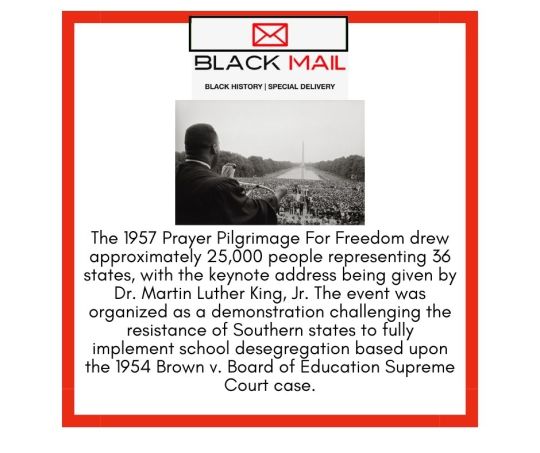
View On WordPress
#Black History#Black History Fact#Black History Month#Brown v. Board of Education#civil rights#Dr. Martin Luther King Jr.
1 note
·
View note
Text
My little brother stood quietly beside his desk with a magnifying glass in his hand.
I looked at him from the splintered frame of our kitchen door where I was standing.
He turned slowly, ln deep thought, and looked at me through the lens of the glass.
His magnified eye was astonishingly big and earthily brown, as big as the whole, wide world and as brown as the turned ground in the fields around our farm.
“Carver, why you up?,” I whispered. “It’s the middle of the night.”
“I cain’t sleep,” he whispered back.
“What you doin’?”
“I’m studyin’ a tomato.”
Sure enough, there was a sliced tomato on his desk, each slice looking very much like the wheels on Daddy’s wagon.
“Did you know,” he asked, “That tomatoes come from the Andes Mountains 'round Peru in South America? And that they're fruits and not vegetables 'cause they’re ripened flower ovaries and contain seeds? And that they're good for your heart?”
I walked over to him and knelt down beside him.
I turned his magnifying glass around and looked into his eye.
I saw clearly the parts of his eye that my teacher taught me at school, the colored part that is the iris and the black part that is the pupil.
But it was Carver who taught me how these parts work together to help us see.
“Carter,”he asked, “Did you know if we divided our brains into five parts, a little more than three of those parts would be used for seeing?
There’s a thin layer on the inside of the eyeball.
It’s the retina.
Nobody could see into the retina until microscopes were invented.
When people looked inside the retina for the first time, they found millions of tiny cells called rods and cones.
Those rods and cones find rays of light and turn them into signals for optic nerves.
The optic nerves send these signals to the brain, and it turns them into pictures.
‘Cause of the way lenses work, the picture is upside down.
The brain turns it right side up.
Idn’ that amazing?”
“Yeah,” I marveled, “It's amazing. And, you know what? So are you.”
He taught me the parts of the eye that helped him see the world as everyone sees it.
In that moment, though, deep in the dark of night, I tried to see the parts that I didn’t understand, the parts that woke my brother up in the middle of the night to study a tomato while our corner of the world slept, the parts that helped him see the world as only Carver could see it.
But those parts remained hidden from me.
I gently put my arm around his shoulders and held him close to me.
“I got you, little buddy,” I whispered. “I got you. And I always will.”
- Trevor Scott Barton, Carter and Carver, 2023
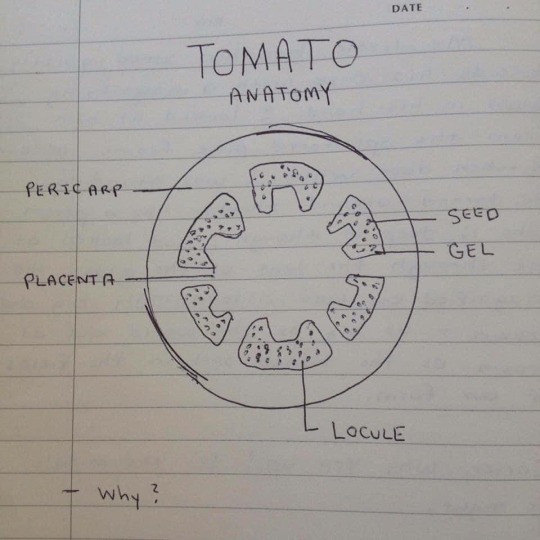
0 notes
Text

One of the most durable myths in recent history is that the religious right, the coalition of conservative evangelicals and fundamentalists, emerged as a political movement in response to the U.S. Supreme Court’s 1973 Roe v. Wade ruling legalizing abortion. The tale goes something like this: Evangelicals, who had been politically quiescent for decades, were so morally outraged by Roe that they resolved to organize in order to overturn it.


This myth of origins is oft repeated by the movement’s leaders. In his 2005 book, Jerry Falwell, the firebrand fundamentalist preacher, recounts his distress upon reading about the ruling in the Jan. 23, 1973, edition of the Lynchburg News: “I sat there staring at the Roe v. Wade story,” Falwell writes, “growing more and more fearful of the consequences of the Supreme Court’s act and wondering why so few voices had been raised against it.” Evangelicals, he decided, needed to organize.
Some of these anti- Roe crusaders even went so far as to call themselves “new abolitionists,” invoking their antebellum predecessors who had fought to eradicate slavery.
But the abortion myth quickly collapses under historical scrutiny. In fact, it wasn’t until 1979—a full six years after Roe—that evangelical leaders, at the behest of conservative activist Paul Weyrich, seized on abortion not for moral reasons, but as a rallying-cry to deny President Jimmy Carter a second term. Why? Because the anti-abortion crusade was more palatable than the religious right’s real motive: protecting segregated schools. So much for the new abolitionism.
Today, evangelicals make up the backbone of the pro-life movement, but it hasn’t always been so. Both before and for several years after Roe, evangelicals were overwhelmingly indifferent to the subject, which they considered a “Catholic issue.” In 1968, for instance, a symposium sponsored by the Christian Medical Society and Christianity Today, the flagship magazine of evangelicalism, refused to characterize abortion as sinful, citing “individual health, family welfare, and social responsibility” as justifications for ending a pregnancy. In 1971, delegates to the Southern Baptist Convention in St. Louis, Missouri, passed a resolution encouraging “Southern Baptists to work for legislation that will allow the possibility of abortion under such conditions as rape, incest, clear evidence of severe fetal deformity, and carefully ascertained evidence of the likelihood of damage to the emotional, mental, and physical health of the mother.” The convention, hardly a redoubt of liberal values, reaffirmed that position in 1974, one year after Roe, and again in 1976.
When the Roe decision was handed down, W. A. Criswell, the Southern Baptist Convention’s former president and pastor of First Baptist Church in Dallas, Texas—also one of the most famous fundamentalists of the 20th century—was pleased: “I have always felt that it was only after a child was born and had a life separate from its mother that it became an individual person,” he said, “and it has always, therefore, seemed to me that what is best for the mother and for the future should be allowed.”
Although a few evangelical voices, including Christianity Today magazine, mildly criticized the ruling, the overwhelming response was silence, even approval. Baptists, in particular, applauded the decision as an appropriate articulation of the division between church and state, between personal morality and state regulation of individual behavior. “Religious liberty, human equality and justice are advanced by the Supreme Court abortion decision,” wrote W. Barry Garrett of Baptist Press.
So what then were the real origins of the religious right? It turns out that the movement can trace its political roots back to a court ruling, but not Roe v. Wade.
In May 1969, a group of African-American parents in Holmes County, Mississippi, sued the Treasury Department to prevent three new whites-only K-12 private academies from securing full tax-exempt status, arguing that their discriminatory policies prevented them from being considered “charitable” institutions. The schools had been founded in the mid-1960s in response to the desegregation of public schools set in motion by the Brown v. Board of Education decision of 1954. In 1969, the first year of desegregation, the number of white students enrolled in public schools in Holmes County dropped from 771 to 28; the following year, that number fell to zero.
In Green v. Kennedy (David Kennedy was secretary of the treasury at the time), decided in January 1970, the plaintiffs won a preliminary injunction, which denied the “segregation academies” tax-exempt status until further review. In the meantime, the government was solidifying its position on such schools. Later that year, President Richard Nixon ordered the Internal Revenue Service to enact a new policy denying tax exemptions to all segregated schools in the United States. Under the provisions of Title VI of the Civil Rights Act, which forbade racial segregation and discrimination, discriminatory schools were not—by definition—“charitable” educational organizations, and therefore they had no claims to tax-exempt status; similarly, donations to such organizations would no longer qualify as tax-deductible contributions.
On June 30, 1971, the United States District Court for the District of Columbia issued its ruling in the case, now Green v. Connally (John Connally had replaced David Kennedy as secretary of the Treasury). The decision upheld the new IRS policy: “Under the Internal Revenue Code, properly construed, racially discriminatory private schools are not entitled to the Federal tax exemption provided for charitable, educational institutions, and persons making gifts to such schools are not entitled to the deductions provided in case of gifts to charitable, educational institutions.”
Paul Weyrich, the late religious conservative political activist and co-founder of the Heritage Foundation, saw his opening.
In the decades following World War II, evangelicals, especially white evangelicals in the North, had drifted toward the Republican Party—inclined in that direction by general Cold War anxieties, vestigial suspicions of Catholicism and well-known evangelist Billy Graham’s very public friendship with Dwight Eisenhower and Richard Nixon. Despite these predilections, though, evangelicals had largely stayed out of the political arena, at least in any organized way. If he could change that, Weyrich reasoned, their large numbers would constitute a formidable voting bloc—one that he could easily marshal behind conservative causes.
“The new political philosophy must be defined by us [conservatives] in moral terms, packaged in non-religious language, and propagated throughout the country by our new coalition,” Weyrich wrote in the mid-1970s. “When political power is achieved, the moral majority will have the opportunity to re-create this great nation.” Weyrich believed that the political possibilities of such a coalition were unlimited. “The leadership, moral philosophy, and workable vehicle are at hand just waiting to be blended and activated,” he wrote. “If the moral majority acts, results could well exceed our wildest dreams.”
But this hypothetical “moral majority” needed a catalyst—a standard around which to rally. For nearly two decades, Weyrich, by his own account, had been trying out different issues, hoping one might pique evangelical interest: pornography, prayer in schools, the proposed Equal Rights Amendment to the Constitution, even abortion. “I was trying to get these people interested in those issues and I utterly failed,” Weyrich recalled at a conference in 1990.
The Green v. Connally ruling provided a necessary first step: It captured the attention of evangelical leaders , especially as the IRS began sending questionnaires to church-related “segregation academies,” including Falwell’s own Lynchburg Christian School, inquiring about their racial policies. Falwell was furious. “In some states,” he famously complained, “It’s easier to open a massage parlor than a Christian school.”
One such school, Bob Jones University—a fundamentalist college in Greenville, South Carolina—was especially obdurate. The IRS had sent its first letter to Bob Jones University in November 1970 to ascertain whether or not it discriminated on the basis of race. The school responded defiantly: It did not admit African Americans.
Although Bob Jones Jr., the school’s founder, argued that racial segregation was mandated by the Bible, Falwell and Weyrich quickly sought to shift the grounds of the debate, framing their opposition in terms of religious freedom rather than in defense of racial segregation. For decades, evangelical leaders had boasted that because their educational institutions accepted no federal money (except for, of course, not having to pay taxes) the government could not tell them how to run their shops—whom to hire or not, whom to admit or reject.
The Civil Rights Act, however, changed that calculus.
(continue reading)
#politics#republicans#paul weyrich#abortion#religious riech#bob jones university#jerry falwell#christian nationalism#white supremacy#desegregation#project 2025#roe v wade#reproductive rights#reproductive justice#healthcare#brown v board of education#heritage foundation#moral majority#religious freedom#religion
195 notes
·
View notes
Text
Seventy years ago this week, the U.S. Supreme Court ruled separating children in schools by race was unconstitutional. On paper, that decision — the fabled Brown v. Board of Education, taught in most every American classroom — still stands. But for decades, American schools have been re-segregating. The country is more diverse than it ever has been, with students more exposed to classmates from different backgrounds. Still, around 4 out of 10 Black and Hispanic students attend schools where almost every one of their classmates is another student of color. The intense segregation by race is linked to socioeconomic conditions: Schools where students of color compose more than 90% of the student body are five times more likely to be located in low-income areas. That in turn has resounding academic consequences: Students who attend high-poverty schools, regardless of their family’s finances, have worse educational outcomes. Efforts to slow or reverse the increasing separation of American schools have stalled. Court cases slowly have chipped away at the dream outlined in the case of Brown v. Board, leaving fewer and fewer tools in the hands of districts to integrate schools by the early 2000s.
16 notes
·
View notes
Photo

Today is the 70th anniversary of the landmark Supreme Court ruling in Brown v. Board of Education (1954).
In this historic civil rights case, the Court unanimously ruled that separating children in public schools on the basis of race is unconstitutional. Their decision marked the end of legalized racial segregation in schools across the country, overruling the "separate but equal" precedent set in the Plessy v. Ferguson (1896) case nearly 60 years prior.
Then and now, the Supreme Court’s decisions determine our rights as citizens. Any time we vote for President or Senators, our ballots can have a direct impact on the Supreme Court.
Honor our past and fight for our future. Register to vote now at weall.vote/register.
142 notes
·
View notes
Text
Brian Bennett at Time:
President Biden drew a parallel on Friday between Donald Trump “and his MAGA Republican allies” and segregationists in the 1950s who tried to prevent Black and white Americans from going to school together.
Speaking to Black leaders gathered at the National Museum of African American History and Culture, Biden described meeting with some of the nine people who faced racist jeers and abuse to attend Little Rock's Central High School in 1957, three years after the Supreme Court ruled segregation in education was unconstitutional. Biden said the same animus that drove segregationists to try to block those students from attending high school with white students is now emerging in “other insidious forms” such as the efforts to gut affirmative action in college admissions and strip away corporate initiatives trying to bring more people of color into workplaces. “The Little Rock Nine were met with vitriol and violence. Today the vitriol comes in other insidious forms—an extreme movement led by my predecessor and his MAGA Republican allies, backed by an extreme Supreme Court that gutted affirmative action in college admissions. My predecessor and his extreme MAGA friends are now going after diversity, equity and inclusion all across America,” Biden said. “They want a country for some —not for all.”
Biden joined the National Association for the Advancement of Colored People (NAACP) to commemorate the 70th anniversary of the 1954 Brown v Board of Education decision that led to a wave of integration across the country. But even after that ruling, local segregationist leaders in many states flouted the court ruling. In an iconic showdown, President Dwight D. Eisenhower sent 101st Airborne Division troops to Little Rock, Arkansas to protect Black students facing violent threats as they attended school. “My name’s Joe Biden and I’m a lifetime member of the NAACP,” he said, as he started his remarks. He then joked, “When I said that a little earlier to the president, he said, ‘Are your dues paid up?’ I got to check.” Biden’s speech was part of a push to engage the African American community at a moment when his approval ratings are sagging among young Black voters. Later on Friday, Biden met at the White House with presidents of the “Divine Nine,” the influential network of Black sororities and fraternities. “I know real power when I see it,” Biden said of the Divine Nine.
At a speech Friday commemorating the 70th anniversary of Brown v. Board of Education, President Joe Biden (D) rightly draws a parallel between the modern-day MAGA cult and the segregationists of years past.
27 notes
·
View notes
Text
On September 24th, 1964, a decade after Brown v. Board of Education ruled that schools must be racially integrated, a crowd of at least 7,500 demonstrators, almost all of whom were white, marched outside New York City Hall to protest a policy aimed at increasing racial integration in the city’s public school system. The protest was organized by two groups formed by white parents: the Parents and Taxpayers Coordinating Council and the Joint Council for Better Education.
The protestors arrived at City Hall with placards to picket against the Board of Education’s decision to institute a compulsory busing program, transferring students to and from only eight elementary schools in the New York City area; four of these schools had mostly white students and four were predominantly Black.
The week prior, the same two groups of white parents sponsored a two-day school boycott at the start of the school year to protest the busing policy. During the boycott, pupil absences were more than double the usual number. The boycott resulted in the loss of $1.6 million in school aid to the New York City public school system because the aid, “intended to compensate communities with rising school populations,” was calculated on the basis of the number of students in attendance at the start of September.
Outside City Hall on September 24, the crowd carried signs that read “we’d rather fight than bus.” The executive secretary of the Parents and Taxpayers Coordinating Council, a white woman named Rosemary Gunning, argued that they were “asking only that the [City] Council take a position in favor of the traditional neighborhood school concept.” Protestors attempted to storm the City Hall after the council members inside voted to uphold the busing initiative, but they were stopped by the police.
To learn more about white Americans’ massive resistance to racial integration and civil rights, read EJI’s report Segregation in America.

#history#white history#us history#black history#am yisrael chai#jumblr#republicans#democrats#September 24 1964#September 24#Brown v. Board of Education#civil rights
0 notes
Text
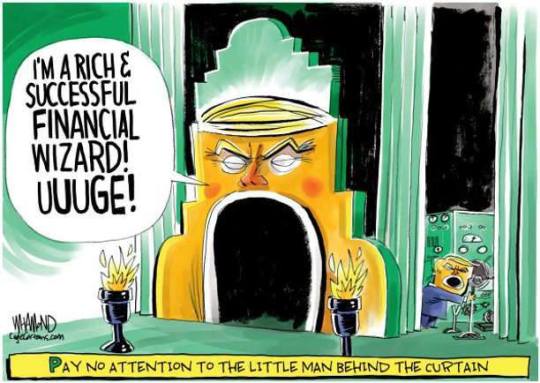
LETTERS FROM AN AMERICAN
May 12, 2024
HEATHER COX RICHARDSON
MAY 13, 2024
I write a lot about how the Biden-Harris administration is working to restore the principles of the period between 1933 and 1981, when members of both political parties widely shared the belief that the government should regulate business, provide a basic social safety net, promote infrastructure, and protect civil rights. And I write about how that so-called liberal consensus broke down as extremists used the Reconstruction-era image of the American cowboy—who, according to myth, wanted nothing from the government but to be left alone—to stand against what they insisted was creeping socialism that stole tax dollars from hardworking white men in order to give handouts to lazy minorities and women.
But five major stories over the past several days made me realize that I’ve never written about how Trump and his loyalists have distorted the cowboy image until it has become a poisonous caricature of the values its recent defenders have claimed to champion.
The cowboy myth originated during the Reconstruction era as a response to the idea that a government that defended Black rights was “socialist” and that the tax dollars required to pay bureaucrats and army officers would break hardworking white men.
This weekend, on Saturday, May 11, Paul Kiel of ProPublica and Russ Buettner of the New York Times teamed up to deliver a deep investigation into what Trump was talking about when he insisted that he must break tradition and refuse to release his tax returns when he ran for office in 2016 and 2020, citing an audit.
The New York Times had already reported that one of the reasons the Internal Revenue Service was auditing Trump’s taxes was that, beginning in 2010, he began to claim a $72.9 million tax refund because of huge losses from his failing casinos.
Kiel and Buettner followed the convoluted web of Trump’s finances to find another issue with his tax history. They concluded that Trump’s Chicago skyscraper, his last major construction project, was “a vast money loser.” He claimed losses as high as $651 million on it in 2008. But then he appears to have moved ownership of the building in 2010 from one entity to a new one—the authors describe it as “like moving coins from one pocket to another”—and used that move to claim another $168 million in losses, thereby double-dipping.
The experts the authors consulted said that if he loses the audit battle, Trump could owe the IRS more than $100 million. University of Baltimore law professor Walter Schwidetzky, who is an expert on partnership taxation, told the authors: “I think he ripped off the tax system.”
The cowboy myth emphasized dominance over the Indigenous Americans and Mexicans allegedly attacking white settlers from the East. On Friday an impressive piece of reporting from Jude Joffe-Block at NPR untangled the origins of a story pushed by Republicans that Democrats were encouraging asylum seekers to vote illegally for President Joe Biden in 2024, revealing that the story was entirely made up.
The story broke on X, formerly Twitter, on April 15, when the investigative arm of the right-wing Heritage Foundation, which promises to provide “aggressive oversight” of the Biden administration, posted photos of what it claimed were flyers from inside portable toilets at a migrant camp in Matamoros, Mexico, that said in broken Spanish: “Reminder to vote for President Biden when you are in the United States. We need another four years of his term to stay open.” The tweet thread got more than 9 million views and was boosted by Elon Musk, X’s owner.
But the story was fabricated. The flyer used the name of a small organization that helps asylum seekers, along with the name of the woman who runs the organization. She is a U.S. citizen and told Joffe-Block that her organization has “never encouraged people to vote for anyone.” Indeed, it has never come up because everyone knows noncitizens are not eligible to vote. The flyer had outdated phone numbers and addresses, and its Spanish was full of errors. Migrants who are staying at the encampment as they wait for their appointments to enter the U.S. say they have never seen such flyers, and no one has urged them to vote for Biden.
Digging showed that the flyer was “discovered” by the right-wing video site Muckraker, which specializes in “undercover” escapades. The founder of Muckraker, Anthony Rubin, and his brother, Joshua Rubin, had shown up at the organization’s headquarters in Matamoros asking to become volunteers for the organization; they and their conversation were captured on video, and signs point to the conclusion that they planted the flyers.
Nonetheless, Republicans ran with the story. Within 12 hours after the fake flyer appeared on X, Republican representatives Marjorie Taylor Greene (R-GA) and Dan Bishop (R-NC) brought posters of it to Congress, and Republicans made it a centerpiece of their insistence that Congress must pass a new law against noncitizen voting. Rather than being protected by modern-day cowboys, the woman who ran the organization that helps asylum seekers got death threats.
The cowboy image emphasized the masculinity of the independent men it championed, but the testimony of Stephanie Clifford, the adult film actress also known as Stormy Daniels, in Trump’s criminal trial for falsifying business records to cover up his payments to Clifford to keep her story of their sexual encounter secret before the 2016 election, turns Trump’s aggressive dominance into sad weakness. Covering Clifford’s testimony, Maureen Dowd of the New York Times yesterday wrote that “Trump came across as a loser in her account—a narcissist, cheater, sad Hugh Hefner wannabe, trading his satin pajamas for a dress shirt and trousers (and, later, boxers) as soon as Stormy mocked him.”
In the literature of the cowboy myth, the young champion of the underdog is eventually supposed to settle down and take care of his family, who adore him. But the news of the past week has caricatured that shift, too. On Wednesday, May 8, the Republican Party of Florida announced that it had picked Trump’s youngest son, 18-year-old Barron, as one of the state’s at-large delegates to the Republican National Convention, along with Trump’s other sons, Eric and Donald Jr.; Don Jr.’s fiancée, Kimberly Guilfoyle; and Trump’s second daughter, Tiffany, and her husband.
On Friday, May 10, Trump’s current wife and Barron’s mother, former first lady Melania Trump, issued a statement saying: “While Barron is honored to have been chosen as a delegate by the Florida Republican Party, he regretfully declines to participate due to prior commitments.” It is hard not to interpret this extraordinary snub from his own wife and son as a chilly response to the past month of testimony about his extramarital escapades while Barron was an infant.
Finally, there was the eye-popping story broken by Josh Dawsey and Maxine Joselow in the Washington Post on Thursday, revealing that last month, at a private meeting with about two dozen top oil executives at Mar-a-Lago, Trump offered to reverse President Joe Biden’s environmental rules designed to combat climate change and to stop any new ones from being enacted in exchange for a $1 billion donation.
Trump has promised his supporters that he would be an outsider, using his knowledge of business to defend ordinary Americans against those elites who don’t care about them. Now he has been revealed as being willing to sell us out—to sell humanity out—for the bargain basement price of $1 billion (with about 8 billion people in the world, this would make us each worth about 12 and a half cents).
Chief White House ethics lawyer in the George W. Bush administration Richard Painter wrote: “This is called bribery. It’s a felony.” He followed up with “Even a candidate who loses can be prosecuted for bribery. That includes the former guy asking for a billion dollars in campaign cash from oil companies in exchange for rolling back environmental laws.”
The cowboy myth was always a political image, designed to undermine the idea of a government that worked for ordinary Americans. It was powerful after the Civil War but faded into the past in the 1920s, 1930s, and 1940s as Americans realized that their lives depended on government regulation and a basic social safety net. The American cowboy burst back into prominence with the advent of the Marlboro Man in 1954, the year of the Supreme Court’s Brown v. Board of Education decision, and the idea of an individual white man who worked hard, wanted nothing from the government but to be left alone, was a sex symbol, and protected his women became a central myth in the rise of politicians determined to overturn the liberal consensus.
Now it seems the myth has come full circle, with the party led by a man whose wife rejects him and whose lovers ridicule him, who makes up stories about dangerous “others,” cheats on his taxes, solicits bribes, and tries to sell out his followers for cash—the very caricature the mythological cowboy was invented to fight.
LETTERS FROM AN AMERICAN
HEATHER COX RICHARDSON
#Letters from An American#Heather Cox Richardson#history#Brown v Board of Education#myth of the cowboy#Ronald Reagan#fake stories#immigration#TFG taxes#tax fraud
16 notes
·
View notes
Text

2 notes
·
View notes